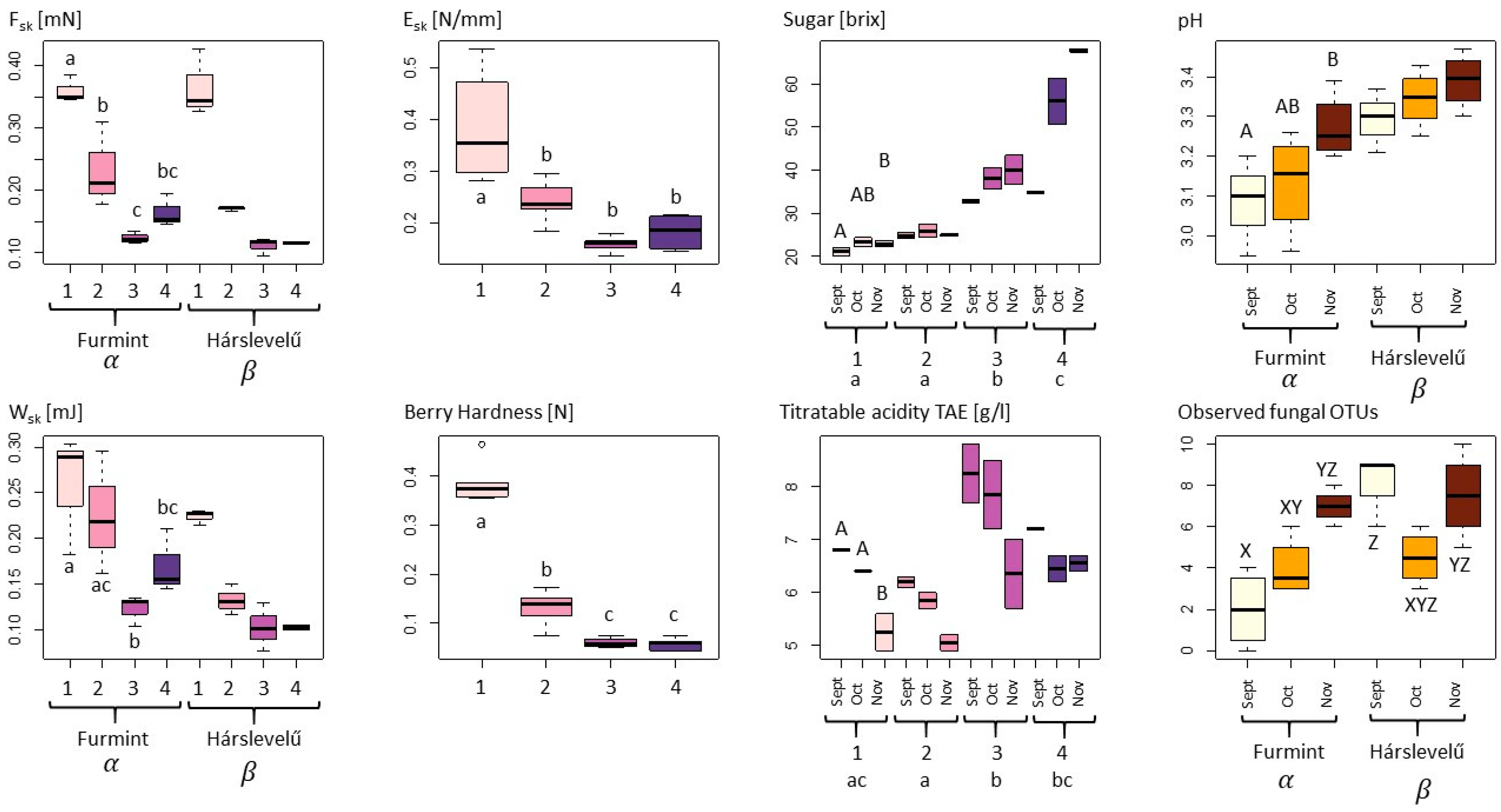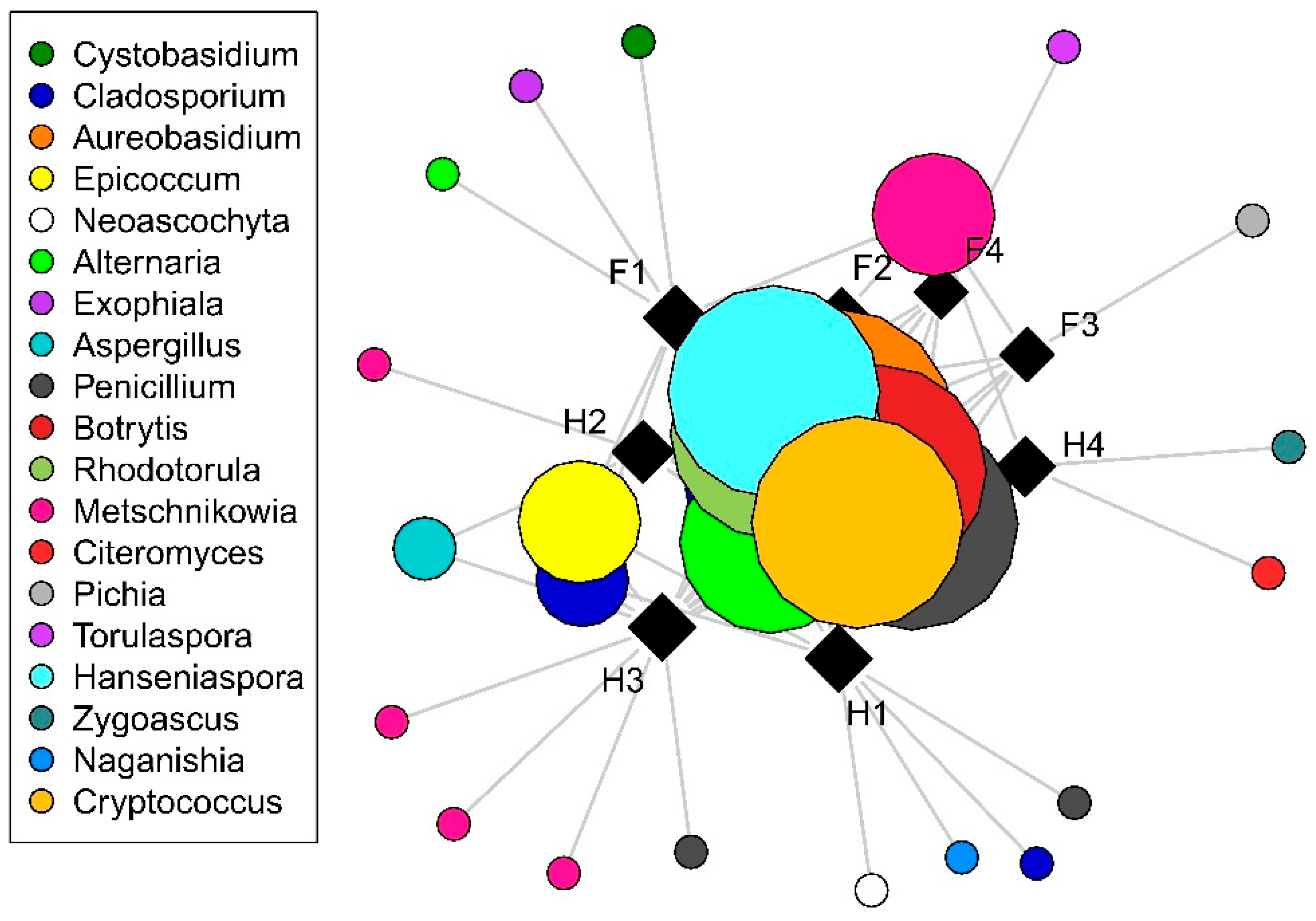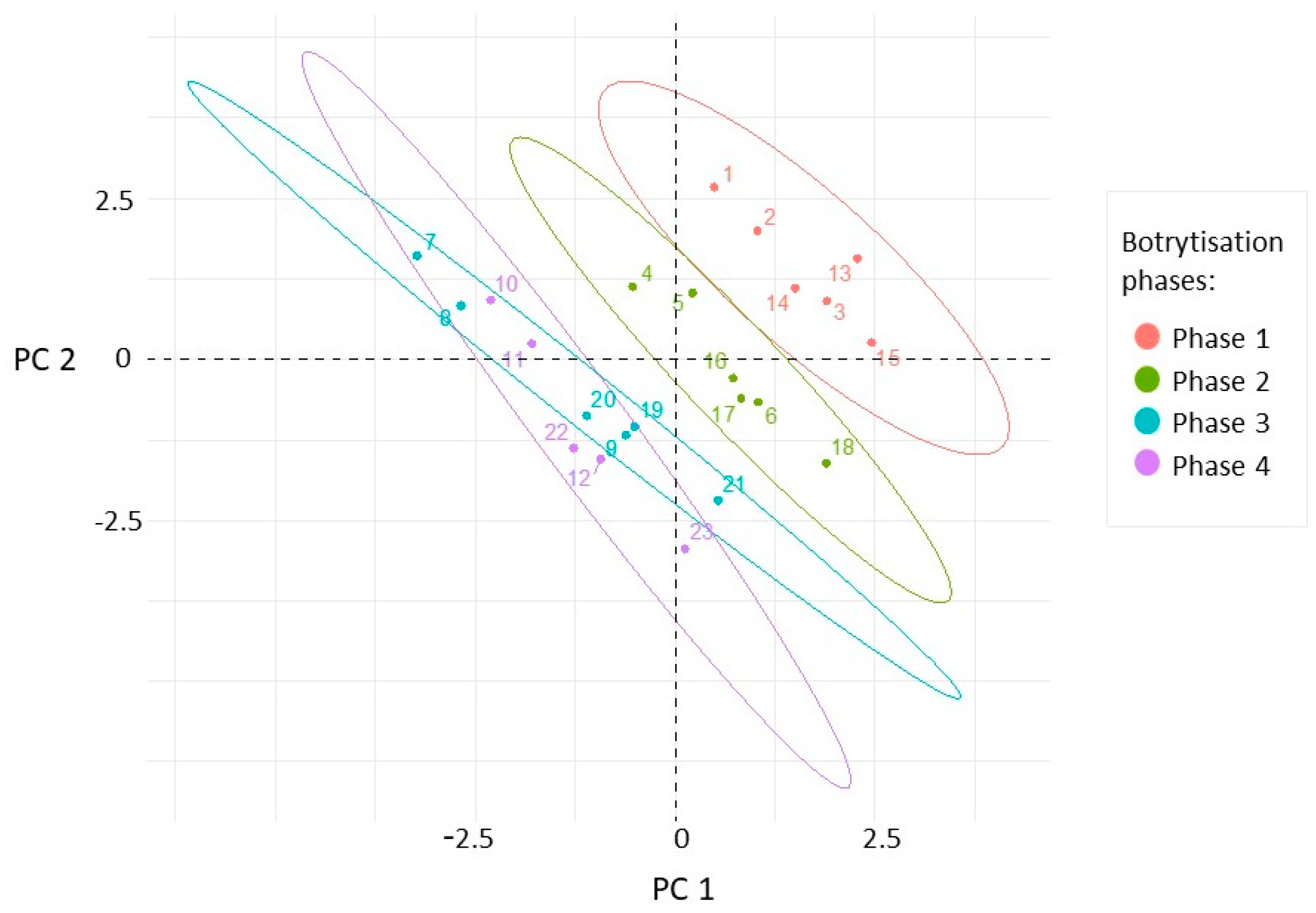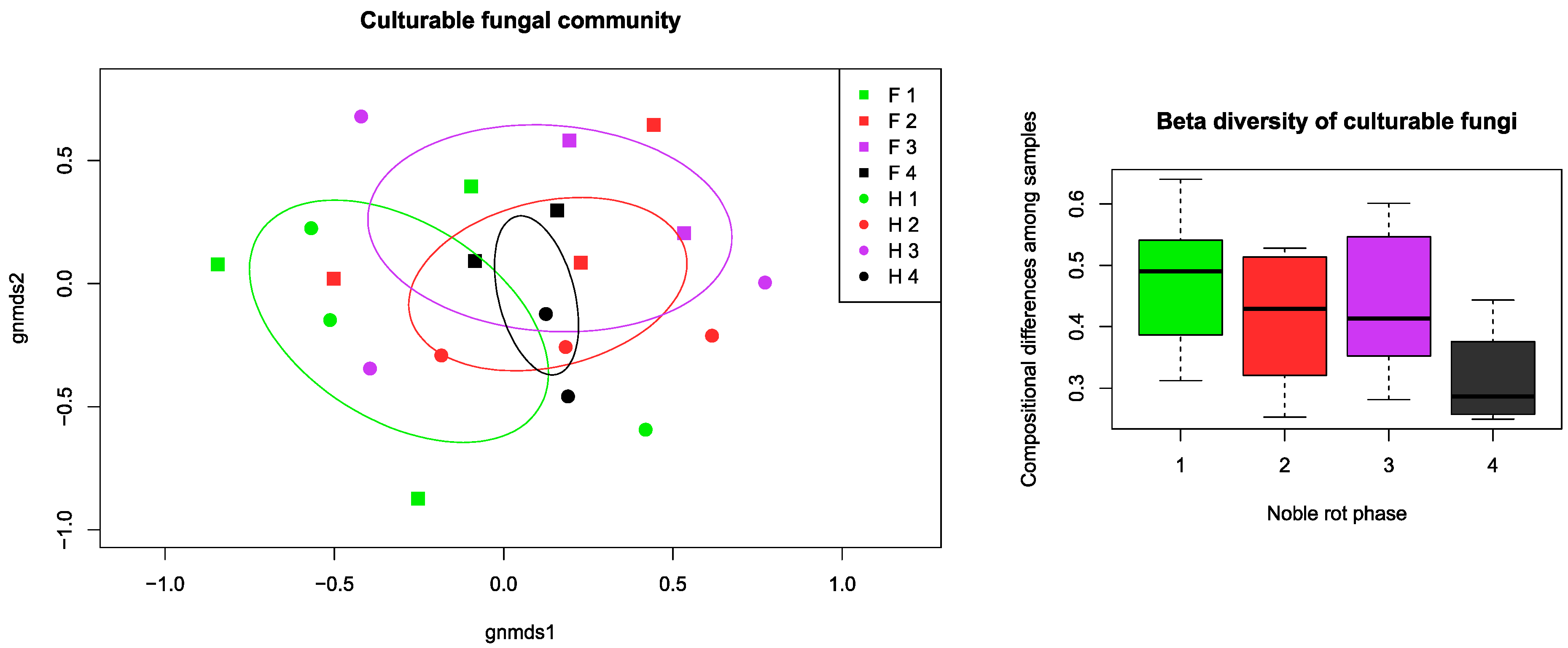Physico-Chemical Characteristics and Culturable Microbial Communities of Grape Berries Change Strongly during Noble Rot Development
Abstract
1. Introduction
2. Results
2.1. Changes in Physical, Chemical and Microbiological Properties during Noble Rot
2.2. Relationships among Physical, Chemical, and Microbiological Variables and Noble Rot Phases
3. Discussion
4. Materials and Methods
4.1. The Sampling Vineyard
4.2. The Sample Collection and Measurement
4.3. Statistical Analyses
5. Conclusions
Supplementary Materials
Author Contributions
Funding
Acknowledgments
Conflicts of Interest
References
- Kerridge, G.; Gackle, A. Vines for Wines: A Wine Lover’s Guide to the Top Wine Grape Varieties; Csiro: Collingwood, Australia, 2004; pp. 39–43. [Google Scholar]
- Echikson, W. Noble Rot: A Bordeaux Wine Revolution; W.W. Norton & Company: New York, NY, USA, 2004. [Google Scholar]
- Ribéreau-Gayon, P.; Dubourdieu, D.; Donéche, B.; Lonvaud, A. Other winemaking methods. In Handbook of Enology, the Microbiology of Wine and Vinifications, 2nd ed.; John Wiley & Sons Ltd.: West Sussex, UK, 2006; Volume 1, pp. 450–458. [Google Scholar]
- Magyar, I.; Soós, J. Botrytized wines–current perspectives. Int. J. Wine Res. 2016, 8, 29–39. [Google Scholar] [CrossRef]
- Magyar, I. Botrytised Wines. In Advances in Food and Nutrition Research Speciality Wines; Jackson, R.S., Ed.; Elsevier Academic Press: Burlington, MA, USA, 2011; Volume 63, pp. 148–197. [Google Scholar]
- Fournier, E.P.; Gladieux, P.; Giraud, T. The ‘Dr Jekyll and Mr Hyde fungus’: Noble rot versus gray mold symptoms of Botrytis cinerea on grapes. Evol. Appl. 2013, 6, 960–969. [Google Scholar] [CrossRef] [PubMed]
- Holtz, G.; Coertze, S.; Williamson, B. The ecology of Botrytis on plant surface. In Botrytis: Biology, Pathology and Control; Elad, Y., Williamson, B., Tudzymski, P., Delen, N., Eds.; Springer: Dordrect, The Netherlands, 2007; pp. 9–27. [Google Scholar]
- Elad, Y.; Vivier, M.; Fillinger, S. Botrytis, the Good, the Bad and the Ugly. In Botrytis—The Fungus, the Pathogen and Its Management in Agricultural Systems; Fillinger, S., Elad, Y., Eds.; Springer: Cham, Germany, 2016; pp. 1–15. [Google Scholar]
- Cantu, D.; Vicente, A.; Greve, L.C.; Dewey, F.M.; Benett, A.B.; Powell, A.L.T. The intersection between cell wall disassembly, ripening, and fruit susceptibility to Botrytis cinerea. Proc. Natl. Acad. Sci. USA 2008, 105, 859–864. [Google Scholar] [CrossRef] [PubMed]
- Hegyi-Kaló, J.; Holb, I.; Lengyel, S.; Juhász, Á.; Váczy, K.Z. Effect of year, sampling month and grape cultivar on noble rot incidence, mycelial growth rate and morphological type of Botrytis cinerea during noble rot development. Eur. J. Plant Pathol. 2019, 155, 339–348. [Google Scholar] [CrossRef]
- Cilibert, N.; Fermaud, M.; Joudet, J.; Rossi, V. Environmental conditions affect Botrytis cinerea infection of mature grape berries more than the strain and transposon genotype. Phytopathology 2015, 105, 1090–1096. [Google Scholar] [CrossRef]
- Carbajal-Ida, D.; Maury, C.; Salas, E.; Siret, R.; Mehinagic, E. Phisicochemical properties of botrytised Chenin blanc grapes to assess the extent of noble rot. Eur. Food Res. Technol. 2016, 242, 117–126. [Google Scholar] [CrossRef]
- Letaief, H.; Rolle, L.; Gerbi, V. Mechanical behaviour of winegrapes under compression tests. Am. J. Enol. Vitic. 2008, 59, 323–329. [Google Scholar]
- Rolle, L. Evolution of mechanical variables of winegrapes for icewine production during on-vine drying. Ital. J. Food Sci. 2010, 22, 143–149. [Google Scholar]
- González-Álvarez, M.; Noguerol-Pato, R.; González-Barreiro, C.; Cancho-Grande, B.; Simal-Gándara, J. Sensory description of sweet wines obtained by the winemaking procedures of raisining, botrytisation and fortification. Food Chem. 2014, 145, 1021–1030. [Google Scholar] [CrossRef]
- Mencarelli, F.; Tonutti, P. Sweet, Reinforced and Fortified Wines: Grape Biochemistry, Technology and Vinification, 1st ed.; John Wiley & Sons Ltd.: West Sussex, UK, 2013. [Google Scholar]
- Tofalo, R.; Chaves-López, C.; Di Fabio, F.; Schirone, M.; Felis, G.E.; Torriani, S.; Paparella, A.; Suzzi, G. Molecular identification and osmotolerant profile of wine yeasts that ferment a high sugar grape must. Int. J. Food Microbiol. 2009, 130, 179–187. [Google Scholar] [CrossRef]
- Understanding the Role of Sugar in Wine. Available online: https://daily.sevenfifty.com/understanding-the-role-of-sugar-in-wine/ (accessed on 13 November 2020).
- Cliff, M.; Yuksel, D.; Girard, B.; King, M. Characterization of Canadian ice wines by sensory and compositional analyses. Am. J. Enol. Vitic. 2020, 53, 46–53. [Google Scholar]
- Chen, Y.; Zhang, W.; Yi, H.; Wang, B.; Xiao, J.; Zhou, X.; Xu, J.; Jiang, L.; Shi, X. Microbial community composition and its role in volatile compound formation during the spontaneous fermentation of ice wine made from Vidal grapes. Process Biochem. 2020, 92, 365–377. [Google Scholar] [CrossRef]
- Bene, Z.; Magyar, I. Characterization of yeast and mould biota of botrytised grapes in Tokaj wine region in the years 2000 and 2001. Acta Aliment. 2004, 33, 259–267. [Google Scholar] [CrossRef]
- Cocolin, L.; Alessandria, V.; Dolci, P.; Gorra, R.; Rantsiou, K. Culture independent methods to assess the diversity and dynamics of microbiota during food fermentation. Int. J. Food Microbiol. 2013, 167, 29–43. [Google Scholar] [CrossRef] [PubMed]
- Blanco-Ulate, B.; Amrine, K.C.H.; Collins, T.S.; Rivero, R.M.; Vicente, A.R.; Morales-Cruz, A.; Doyle, C.L.; Ye, Z.; Allen, G.; Heymann, H.; et al. Developmental and metabolic plasticity of white-skinned grape berries in response to Botrytis cinerea during noble rot. Plant Physiol. 2015, 169, 2422–2443. [Google Scholar] [CrossRef][Green Version]
- Azzolini, M.; Tosi, E.; Faccio, S.; Lorenzini, M.; Torriani, S.; Zapparoli, G. Selection of Botrytis cinerea and Saccharomyces cerevisiae strains for the improvement and valorization of Italian passito style wines. FEMS Yeast Res. 2013, 13, 540–552. [Google Scholar] [CrossRef] [PubMed]
- Martins, G.; Miot-Sertier, C.; Lauga, B.; Claisse, O.; Lonvaud-Funel, A.; Soulas, G.; Masneuf-Pomarède, I. Grape berry bacterial microbiota: Impact of the ripening process and the farming system. Int. J. Food Microbiol. 2013, 158, 93–100. [Google Scholar] [CrossRef] [PubMed]
- Bokulich, N.A.; Thorngate, J.H.; Richardson, P.M.; Mills, D.A. Microbial biogeography of wine grapes is conditioned by cultivar, vintage, and climate. Proc. Natl. Acad. Sci. USA 2014, 111, E139–E148. [Google Scholar] [CrossRef]
- Mikusova, P.; Ritieni, A.; Juhasová, G.; Srobárova, A. Contamination by moulds of grape berries in Slovakia. Food Addit. Contam. 2010, 27, 738–747. [Google Scholar] [CrossRef]
- Hegyi-Kaló, J.; Lengyel, S.; Szalóki, N.; Szén, O.; Juhász, Á.; Váczy, K.Z. Microbial ecology on grape berries of different botrytisation phases. Növényvédelem 2017, 53, 507–512. [Google Scholar]
- Barata, A.; Malfeito-Ferreira, M.; Loureiro, V. The microbial ecology of wine grape berries. Int. J. Food Microbiol. 2012, 153, 243–259. [Google Scholar] [CrossRef] [PubMed]
- Bokulich, N.A.; Ohta, M.; Richardson, P.M.; Mills, D.A. Monitoring seasonal changes in winery-resident microbiota. PLoS ONE 2013, 8, e66437. [Google Scholar] [CrossRef] [PubMed]
- Sato, A.; Yamane, H.; Hirakawa, N.; Otobe, K.; Yamada, M. Varietal differences in the texture of grape berries measured by penetration tests. Vitis 1997, 36, 7–10. [Google Scholar]
- Renouf, V.; Claisse, O.; Lonvaud-Funel, A. Understanding the microbial ecosystem on the grape berry surface through numeration and identification of yeast and bacteria. Aust. J. Grape Wine Res. 2005, 11, 316–327. [Google Scholar] [CrossRef]
- Letaief, H.; Rolle, L.; Zeppa, G.; Gerbi, V. Assessment of grape skin hardness by a puncture test. J. Sci. Food Agric. 2008, 88, 1567–1575. [Google Scholar] [CrossRef]
- Doumouya, S.; Lahaye, C.; Maury, C.; René, S. Physical and physiological heterogeneity within the grape bunch: Impact on mechanical properties during maturation. Am. J. Enol. Vitic. 2014, 65, 170–178. [Google Scholar] [CrossRef]
- Pinar, A.L.; Rauhut, D.; Ruehl, E.; Buettner, A. Effects of Botrytis cinerea and Erysiphe necator fungi on the aroma character of grape must: A comparative approach. Food Chem. 2016, 207, 251–260. [Google Scholar] [CrossRef]
- Miklósy, É.; Kerényi, Z. Comparison of the volatile aroma components in noble rotted grape berries from two different locations of the Tokaj wine district in Hungary. Anal. Chim. Acta 2004, 513, 177–181. [Google Scholar] [CrossRef]
- Deytieux-Belleau, C.; Geny, L.; Roudet, J.; Mayet, V.; Donéche, B.; Fermaud, M. Grape berry skin features related to ontogenic resistance to Botrytis cinerea. Eur. J. Plant Pathol. 2009, 125, 551. [Google Scholar] [CrossRef]
- Kiss, J.; Sass-Kiss, A. Protection of originality of Tokaji Aszú: Amines and organic acids in botrytized wines by high-performance liquid chromatography. J. Agric. Food Chem. 2005, 53, 10042–10050. [Google Scholar] [CrossRef]
- Bartowsky, E.J. Bacterial spoilage of wine and approaches to minimize it. Lett. Appl. Microbiol. 2009, 48, 149–156. [Google Scholar] [CrossRef] [PubMed]
- White, T.J.; Bruns, T.; Lee, S.B.; Taylor, J.W. Amplification and direct sequencing of fungal ribosomal RNA for phylogenetics. In PCR Protocols: A Guide to Methods and Applications; Innis, M.A., Gelfand, D.H., Sninsky, J.J., White, T.J., Eds.; Academic Press: San Diego, CA, USA, 1990; pp. 315–321. [Google Scholar]
- Kurtzman, C.P.; Fell, J.W. The Yeasts, 4th ed.; Elsevier: Amsterdam, The Netherlands, 1998; pp. 3–73. [Google Scholar]
- Edgar, R.C. Search and clustering orders of magnitude faster than BLAST. Bioinformatics 2010, 26, 2460–2461. [Google Scholar] [CrossRef] [PubMed]
- Oksanen, J.; Blanchet, F.G.; Friendly, M.; Kindt, R.; Legendre, P.; McGlinn, D.; Minchin, P.R.; O’Hara, R.B.; Simpson, G.L.; Solymos, P.; et al. Package ‘Vegan’. Community Ecology Package, Version 2.5-7. 2020. Available online: http://CRAN.R-project.org/package=vegan (accessed on 18 December 2020).
- Butts, C.T. Social network analysis with sna. J. Stat. Softw. 2008, 24, 1–51. [Google Scholar] [CrossRef]





| Best Fit Model | AICcwt (%) | p-Value | |
|---|---|---|---|
| Fsk | Phases + Cultivars | 54 | Ph: 2.16 × 10−9 |
| C: 1.47 × 10−1 | |||
| Esk | Phases | 75 | Ph: 9.56 × 10−6 |
| Wsk | Phases + Cultivars | 96 | Ph: 1.43 × 10−4 |
| C: 6.55 × 10−3 | |||
| BH | Phases | 84 | Ph: 4.95 × 10−14 |
| Sugar | Phases + Collection times | 47 | Ph: 1.74 × 10−7 |
| Ct: 4.42 × 10−2 | |||
| pH | Cultivars + Collection times | 70 | C: 1.2 × 10−4 |
| Ct: 2.07 × 10−2 | |||
| TA | Phases + Collection times | 100 | Ph: 9.26 × 10−5 |
| Ct: 3.44 × 10−4 | |||
| Fungal OTUs | Cultivars * Collection times | 95 | C: 3.62 × 10−3 |
| Ct: 3.03 × 10−3 | |||
| C*Ct: 5.02 × 10−3 |
| Phylum | Order | Genus | F 1 | F 2 | F 3 | F 4 | H 1 | H 2 | H 3 | H 4 |
|---|---|---|---|---|---|---|---|---|---|---|
| Ascomycota | Capnodiales | Cladosporium | 3 | 3 | 0 | 2 | 8 | 4 | 3 | 2 |
| Ascomycota | Dothideales | Aureobasidium | 4 | 5 | 3 | 3 | 5 | 4 | 2 | 2 |
| Ascomycota | Pleosporales | Alternaria | 2 | 1 | 0 | 0 | 1 | 2 | 1 | 1 |
| Ascomycota | Pleosporales | Epicoccum | 1 | 0 | 0 | 0 | 1 | 1 | 2 | 0 |
| Ascomycota | Pleosporales | Neoascochyta | 0 | 0 | 0 | 0 | 1 | 0 | 0 | 0 |
| Ascomycota | Chaetothyriales | Exophiala | 1 | 0 | 0 | 0 | 0 | 0 | 0 | 0 |
| Ascomycota | Eurotiales | Aspergillus | 0 | 0 | 0 | 0 | 0 | 2 | 2 | 0 |
| Ascomycota | Eurotiales | Penicillium | 0 | 2 | 2 | 2 | 5 | 1 | 2 | 2 |
| Ascomycota | Helotiales | Botrytis | 1 | 0 | 1 | 1 | 2 | 4 | 2 | 3 |
| Ascomycota | Saccharomycetales | Citeromyces | 0 | 0 | 0 | 0 | 0 | 0 | 0 | 1 |
| Ascomycota | Saccharomycetales | Hanseniaspora | 1 | 5 | 5 | 1 | 1 | 3 | 2 | 0 |
| Ascomycota | Saccharomycetales | Metschnikowia | 1 | 1 | 1 | 0 | 0 | 1 | 3 | 1 |
| Ascomycota | Saccharomycetales | Pichia | 0 | 0 | 1 | 0 | 0 | 0 | 0 | 0 |
| Ascomycota | Saccharomycetales | Torulaspora | 0 | 0 | 0 | 1 | 0 | 0 | 0 | 0 |
| Ascomycota | Saccharomycetales | Zygoascus | 0 | 0 | 0 | 0 | 0 | 0 | 0 | 1 |
| Basidiomycota | Cystobasidiales | Cystobasidium | 1 | 0 | 0 | 0 | 0 | 0 | 0 | 0 |
| Basidiomycota | Sporidiobolales | Rhodotorula | 2 | 2 | 0 | 2 | 4 | 1 | 3 | 1 |
| Basidiomycota | Filobasidiales | Naganishia | 0 | 0 | 0 | 0 | 1 | 0 | 0 | 0 |
| Basidiomycota | Tremellales | Cryptococcus | 1 | 1 | 1 | 0 | 1 | 1 | 2 | 2 |
| Noble Rot Phase | Sampling Month | Cultivar | ||||
|---|---|---|---|---|---|---|
| Variable | Var. (%) | p | Var. (%) | p | Var. (%) | p |
| Texture | 57 | 0.001 | 31 | 0.001 | 12 | 0.057 |
| Analytics | 72 | 0.001 | 11 | 0.12 | 0 | 0.835 |
| Fungal community | 21 | 0.031 | 22 | 0.014 | 25 | 0.014 |
Publisher’s Note: MDPI stays neutral with regard to jurisdictional claims in published maps and institutional affiliations. |
© 2020 by the authors. Licensee MDPI, Basel, Switzerland. This article is an open access article distributed under the terms and conditions of the Creative Commons Attribution (CC BY) license (http://creativecommons.org/licenses/by/4.0/).
Share and Cite
Hegyi-Kaló, J.; Hegyi, Á.I.; Geml, J.; Zsófi, Z.; Pálfi, X.; Váczy, K.Z. Physico-Chemical Characteristics and Culturable Microbial Communities of Grape Berries Change Strongly during Noble Rot Development. Plants 2020, 9, 1809. https://doi.org/10.3390/plants9121809
Hegyi-Kaló J, Hegyi ÁI, Geml J, Zsófi Z, Pálfi X, Váczy KZ. Physico-Chemical Characteristics and Culturable Microbial Communities of Grape Berries Change Strongly during Noble Rot Development. Plants. 2020; 9(12):1809. https://doi.org/10.3390/plants9121809
Chicago/Turabian StyleHegyi-Kaló, Júlia, Ádám István Hegyi, József Geml, Zsolt Zsófi, Xénia Pálfi, and Kálmán Zoltán Váczy. 2020. "Physico-Chemical Characteristics and Culturable Microbial Communities of Grape Berries Change Strongly during Noble Rot Development" Plants 9, no. 12: 1809. https://doi.org/10.3390/plants9121809
APA StyleHegyi-Kaló, J., Hegyi, Á. I., Geml, J., Zsófi, Z., Pálfi, X., & Váczy, K. Z. (2020). Physico-Chemical Characteristics and Culturable Microbial Communities of Grape Berries Change Strongly during Noble Rot Development. Plants, 9(12), 1809. https://doi.org/10.3390/plants9121809






